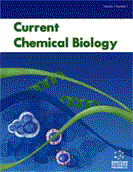Abstract
P53 is one of the most important tumour suppressor proteins. While its activity seems to be dispensable for normal proliferating cells, this protein is required to maintain genomic integrity after DNA damage. In response to cellular stress, the amount of p53 protein accumulates and fulfils its function as a transcription factor. Most of the genes that are regulated by p53 control progression through the cell cycle or initiate cell death. A large number of proteins have been identified in recent years that control the activity of this important tumour suppressor protein. These proteins regulate the turnover of p53, its association with co-repressor and co-activator proteins and target gene promoters or impinge on p53 oligomerisation. This review shall give an overview of our current knowledge on how the activity of the p53 protein is controlled.
Keywords: p53, DNA damage, phosphorylation, acetylation, ubiquitination, protein-protein interactions
Current Chemical Biology
Title: Regulation of p53 Activity
Volume: 4 Issue: 1
Author(s): Karen A. Boehme and Christine Blattner
Affiliation:
Keywords: p53, DNA damage, phosphorylation, acetylation, ubiquitination, protein-protein interactions
Abstract: P53 is one of the most important tumour suppressor proteins. While its activity seems to be dispensable for normal proliferating cells, this protein is required to maintain genomic integrity after DNA damage. In response to cellular stress, the amount of p53 protein accumulates and fulfils its function as a transcription factor. Most of the genes that are regulated by p53 control progression through the cell cycle or initiate cell death. A large number of proteins have been identified in recent years that control the activity of this important tumour suppressor protein. These proteins regulate the turnover of p53, its association with co-repressor and co-activator proteins and target gene promoters or impinge on p53 oligomerisation. This review shall give an overview of our current knowledge on how the activity of the p53 protein is controlled.
Export Options
About this article
Cite this article as:
Boehme A. Karen and Blattner Christine, Regulation of p53 Activity, Current Chemical Biology 2010; 4 (1) . https://dx.doi.org/10.2174/2212796811004010001
| DOI https://dx.doi.org/10.2174/2212796811004010001 |
Print ISSN 2212-7968 |
| Publisher Name Bentham Science Publisher |
Online ISSN 1872-3136 |
 43
43
- Author Guidelines
- Bentham Author Support Services (BASS)
- Graphical Abstracts
- Fabricating and Stating False Information
- Research Misconduct
- Post Publication Discussions and Corrections
- Publishing Ethics and Rectitude
- Increase Visibility of Your Article
- Archiving Policies
- Peer Review Workflow
- Order Your Article Before Print
- Promote Your Article
- Manuscript Transfer Facility
- Editorial Policies
- Allegations from Whistleblowers
- Announcements
Related Articles
-
Perspectives of Benzimidazole Derivatives as Anticancer Agents in the New Era
Anti-Cancer Agents in Medicinal Chemistry Increased Protein Oxidation and Loss of Protein-Bound Sialic Acid in Hepatic Tissues of D-galactose Induced Aged Rats
Current Aging Science EphA2-Dependent Molecular Targeting Therapy for Malignant Tumors
Current Cancer Drug Targets Molecular Evidence of Compound Kushen Injection Against Lung Cancer: A Network Pharmacology-Based Investigation from Western Medicine to Traditional Medicine
Anti-Cancer Agents in Medicinal Chemistry The Warburg Effect: Why and How Do Cancer Cells Activate Glycolysis in the Presence of Oxygen?
Anti-Cancer Agents in Medicinal Chemistry Emerging Immunotargets in Bladder Cancer
Current Drug Targets Metastasis: Recent Discoveries and Novel Perioperative Treatment Strategies with Particular Interest in the Hemostatic Compound Desmopressin
Current Pharmaceutical Biotechnology Clinical Pharmacogenetics of Methotrexate
Current Drug Metabolism Establishing Genomic/Transcriptomic Links Between Alzheimer’s Disease and Type 2 Diabetes Mellitus by Meta-Analysis Approach
CNS & Neurological Disorders - Drug Targets Ion Transport Across the Gallbladder Epithelium
Current Drug Targets - Immune, Endocrine & Metabolic Disorders MicroRNA Regulation of TRAIL in Renal Carcinoma: Tiny Juggernauts at Work
Current Molecular Pharmacology Natural Products Derived from Traditional Chinese Medicine as Novel Inhibitors of the Epidermal Growth Factor Receptor
Combinatorial Chemistry & High Throughput Screening Intracellular Signaling Triggered by Formyl-Peptide Receptors in Nonphagocytic Cells
Current Signal Transduction Therapy Role of Aberrant Lipid Metabolism of Cancer Stem Cells in Cancer Progression
Current Cancer Drug Targets Activated Immune System and Inflammation in Healthy Ageing: Relevance for Tryptophan and Neopterin Metabolism
Current Pharmaceutical Design Medicinal and Beneficial Health Applications of Tinospora cordifolia (Guduchi): A Miraculous Herb Countering Various Diseases/Disorders and its Immunomodulatory Effects
Recent Patents on Endocrine, Metabolic & Immune Drug Discovery (Discontinued) Review of and Perspectives on the Toxicology of Graphene-based Materials
Current Drug Metabolism β-Carboline Alkaloids: Biochemical and Pharmacological Functions
Current Medicinal Chemistry Recent Advances in Improving Sub-Unit Vaccine Efficacy Using Cytokines as more Specific Immune Inducing Adjuvants
Anti-Inflammatory & Anti-Allergy Agents in Medicinal Chemistry Gene Therapy of Cancer Based on Interleukin 12
Current Gene Therapy

















.jpeg)








